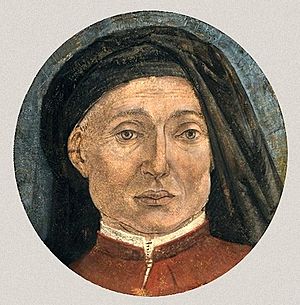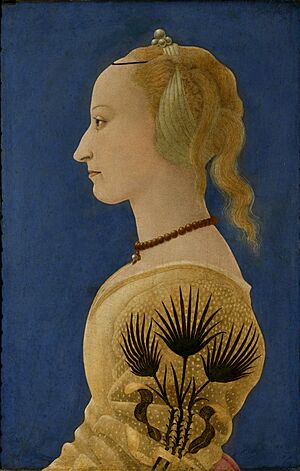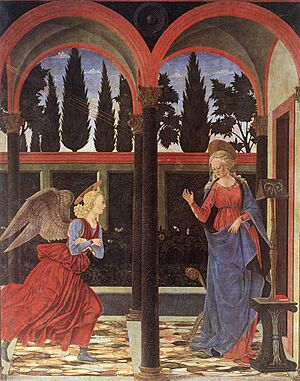Alesso Baldovinetti facts for kids
Alesso Baldovinetti (born October 14, 1427 – died August 29, 1499) was an Italian painter and artist from the early Renaissance period. He was known for his detailed paintings and his experiments with new art techniques.
Biography
Alesso Baldovinetti was born in Florence, Italy. His family was wealthy and worked as merchants. In 1448, when he was 21, he officially became a member of the Guild of St. Luke. This was an important group for painters and artists.
Alesso followed a group of artists who loved to make their art look very real and natural. These artists included Andrea del Castagno, Paolo Uccello, and Domenico Veneziano. It's thought that Alesso helped paint the church of S. Egidio, but there are no clear records to prove it. He was definitely hired later, in 1460, to finish some paintings there.
In 1460, Alesso was asked to paint a large fresco called the Annunciation. It was for the cloister (an open walkway) of the Annunziata basilica. Even today, you can see how good he was at painting tiny details from nature. He also made his figures look like they were in a huge, airy landscape.
A writer named Giorgio Vasari said that Alesso loved to draw landscapes exactly as they looked in nature. He would paint rivers, bridges, rocks, plants, fruits, roads, fields, and even cities. Vasari also mentioned that Alesso loved to try new things with his painting methods.
Alesso often started his wall paintings using the fresco method. This means painting on wet plaster. Then, he would finish them a secco, which means painting on dry plaster. For the a secco parts, he used a special mix of egg yolk and varnish. He hoped this would protect his paintings from dampness. But over time, these parts often peeled off, so his secret method didn't work out as he hoped.
In 1463, he designed a picture of the Nativity (the birth of Jesus). This design was then made into a wooden inlay (called tarsia) by Giuliano da Maiano. You can still see it in the sacristy (a room for priests) of the cathedral. Around 1465, he painted the famous Portrait of a Lady in Yellow.
From 1466, Alesso painted groups of four Evangelists and four Fathers of the Church as frescoes. He also painted an Annunciation on a panel. These still decorate the Portuguese chapel in the San Miniato basilica.
In 1471, Alesso started important work for the church of Santa Trinita. He was hired by Bongianni Gianfigliazzi. First, he painted an altar-piece of the Holy Trinity with saints, which he finished in 1472. Next, he began a series of frescoes showing scenes from the Old Testament. This project was supposed to take five years, but it actually took him 26 years to finish!
By 1497, the finished series of frescoes was valued at a thousand gold florins. Many famous Florentine citizens were painted in these frescoes. Sadly, only a few damaged pieces remain today.
Alesso also spent a lot of time on other artistic projects and experiments. His friends thought he had rediscovered the old art of mosaics, which had not been used much for a long time. Because of this, he was hired between 1481 and 1483 to fix mosaics. He repaired the mosaics over the door of the S. Miniato church and also some inside and outside the baptistery of the cathedral.
Alesso Baldovinetti passed away on August 29, 1499, in the San Paolo hospital. He was buried in San Lorenzo. One of his most famous students was Domenico Ghirlandaio.
See also
 In Spanish: Alesso Baldovinetti para niños
In Spanish: Alesso Baldovinetti para niños




